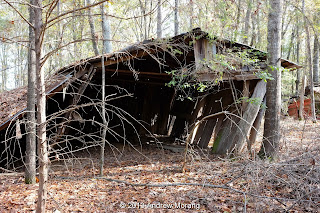But this time, I want to show you that the opposite is possible: urban preservation. Redlands, California, a bedroom community about 60 miles east of Los Angeles, is the "Jewel of the Inland Empire."
The streets in the historic district are planted with spectacular palms. From Wikipedia, "At the turn of the 20th century, Redlands was the "Palm Springs" of the next century, with roses being planted along many city thoroughfares. Some of these plantings would survive as wild thickets into the 1970s, especially adjacent to orange groves where property management was lax. Washingtonia palms (Washingtonia robusta) were planted along many main avenues. In fact, Redlands was the first city to have center medians with trees or gardens in between roads. So beautifully kept was the area, with the dramatic mountain backdrops, that for several years the Santa Fe Railroad operated excursion trains along the loop that passed through the orange groves of Redlands and Mentone, across the Santa Ana River, and back into San Bernardino via East Highlands, Highlands and Patton…"
 |
| 1908 panorama of Redlands, California |
The 1908 panorama shows the rows and rows of orange and grapefruit trees. This was a major commodity in the early 20th century, made possible by an efficient railroad infrastructure and a complex water system, which allowed irrigation in this semi-arid setting.
It is an eye-opener to visit a city like Redlands with its collection of early 20th century houses in amazing condition. Several factors must have contributed:
- The climate: Redlands is dry, and wood does not rot as rapidly as in wetter areas.
- Residents lived in their historic houses, precluding a large-scale conversion to rentals.
- They were wealthy enough to maintain their houses properly over the decades.
- The city may have been wise enough to offer incentives to maintain the historical areas.
- The city may have had strict zoning.
- Somehow Redlands avoided the scourge of white flight (for an extreme example, see Detroit).
- And most important, the residents had pride.
 |
| Cajon Street from East Vine, view southeast. |
 |
| 215 Cajon Street. Note the arch-topped inset balcony on the third floor. |
 |
| A professional office at 256 Cajon Street. |
 |
| 425 Cajon Street, another property with lush vegetation. |
 |
| 504 Cajon Street. Cool tower sticking out of the roof, and handsome wrap-around porch. |
 |
| 513 Cajon Street, a bit more severe than the previous examples, but with a distinctive dormer on the third floor. |
 |
| 523 Cajon Street. A handome Victorian with a wrap-around porch. |
 |
| 633 Cajon Street. Note the amazing tree house. |
 |
| 726 Cajon Street. |
 |
| 734 Cajon Street. Flowers and an amazing cactus under the tree. |
 |
| 755 Cajon Street, Spanish style in a somewhat severe interpretation. |
 |
| 928 Cajon Street, another example with a great corner tower and dormer window. This is almost a mirror image of 504. And this one has rose trees... |
 |
| 1004 Cajon Street, an impressive Victorian in immaculate condition. I love the corner tower. |
Olive was another elegant residential street. One of the more unusual homes is at 405 West Olive. This exuberant pseudo-Moorish design was (is) a bit over the top, but it fits in the Southern California setting. It was built in 1903 for William F. Holt, a St. Louis developer and capitalist. One of its unusual features is a 1-lane bowling alley in the basement. Many of Redlands' finer homes were built in the turn of the century by wealthy easterners, who came to southern California in the winter months to escape snow and pollution.
 |
| Olive Apartments, 24 West Olive Avenue. Notice the repeating theme of the arches. |
 |
| 316 West Olive Avenue. Elegant wood house with detail woodwork on the balcony. |
 |
| 533 West Olive Avenue. Arts and crafts cottages like this are common in Redlands. |
 |
| 501 West Olive Avenue. |
 |
| Alvadaro Street. I have seen handsome houses like this in Pittsburgh and other eastern cities. Note the impressive clay tile roof and the balcony-dormer. |
 |
| 621 Alvarado Street, surrounded by the lush vegetation. |
 |
| Alvarado Street. A ranch style with immaculate garden. |
 |
| Alvarado Street. A large version of an Arts and Crafts cottage. The pillars made of river rock are seen in many houses here. |
 |
| 103 South Beuna Vista Street. |
 |
| 105 South Center Street |
Close by are South Center and South Buena Vista Streets, also with nicely-maintained properties.
 |
| 511 Linda Place |
 |
| 623 Linda Place |
 |
| 604 Linda Place, with drought-tolerant plants instead of lawn. |
 |
| 604 Linda Place, with unusual river rock walls but no posts - the roof cantilevers out over the porch. |
 |
| This is an amazing:sight: mahogany tongue-and-groove flooring. |
The unusual kitchen tiles that show early 20th century advertisements from the citrus packers.
A recent Redlands home-buyer documents her adventures in her Time-Axis blog. You can read about lead paint over the ages and similar topics. Click the link to see the Santa Fe depot in Redlands.
This is a portal for the Inland Empire, the area east of Los Angeles. It was once a lush paradise of citrus farms, but now much has been despoiled by suburban sprawl and industry.
Photographs taken with a Panasonic G3 camera, most with the 20 mm f/1.7 Lumix lens. Raw files reprocessed with PhotoNinja.
















































